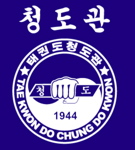Low purple belt
Forms
- Pyung-Ahn Sa Don
- Pyung-Ahn O Don
- Kuk Mu Sa Don
Can perform the pattern correctly, can attack the target areas correctly.
Has good stances and good motion, good speed and power.
Kicking
Can kick at least mid to high chest level, hitting with heel.
Sparring
- Instant Sparring
- Self-defense (can demonstrate defense against wrist-grab, simple-choke, bear-hug)
- Target areas (know the famous 5 prime target areas: throat, groin, knees, eyes, and
nose)
- One-step sparring
- Free sparring
- Previous sparring drills
Makes good use of space, moving well with opponent. Starts to show
good power and snap in techniques. Has good speed in movement and attacking.
Can perform the Grandmaster Kim's standard seven one-step techniques
(punch-uppercut,duck,snake,knife-hand-punch,knife-hand-reverse-elbow,side-kick-back-kick,
crescent-side-kick).
Korean Terminology and Martial Arts Philosophy
- Previous terms+
- Know all Korean terms to start and end classes.
- Start understanding some of the reasons we do things the way we do (non-contact sparring etc.)








 For more information Contact Master Erik Kluzek at: erik@coloradobluewave.org or (303)772-6225 or
mail to COBWAMA, PO Box 2507, Longmont CO 80502-2507
For more information Contact Master Erik Kluzek at: erik@coloradobluewave.org or (303)772-6225 or
mail to COBWAMA, PO Box 2507, Longmont CO 80502-2507